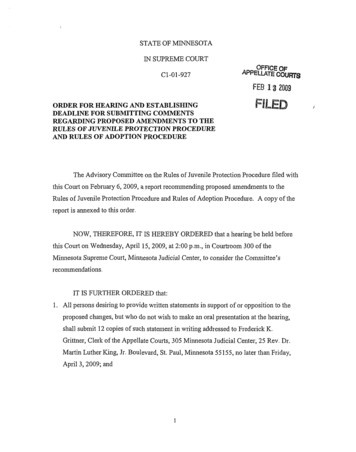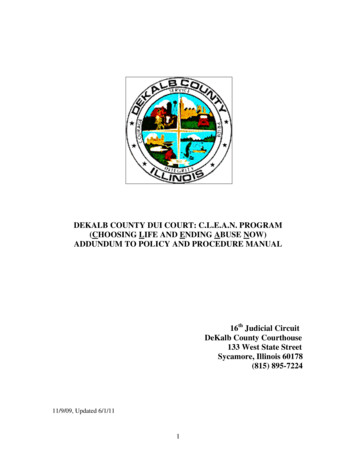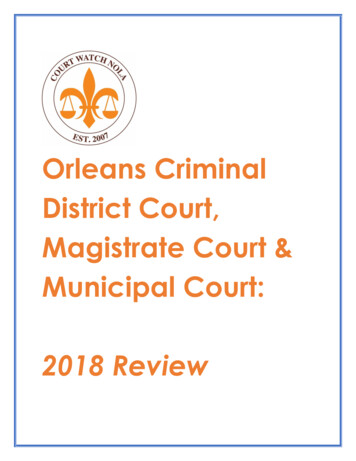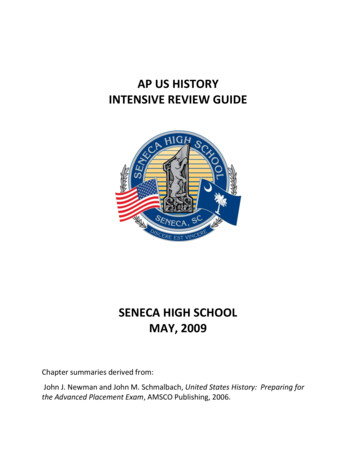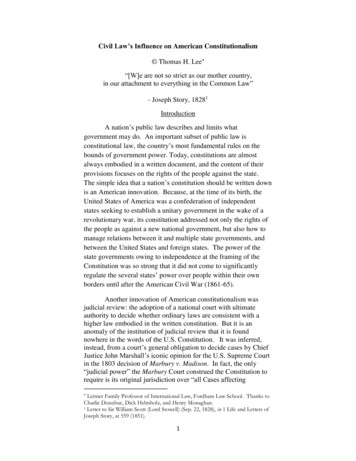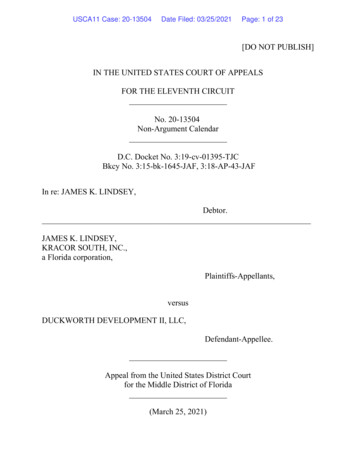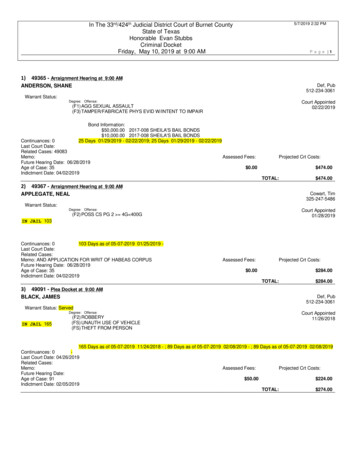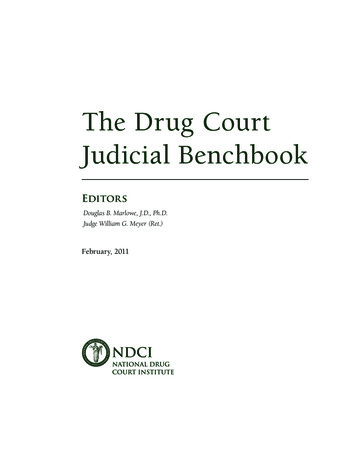
Transcription
The Drug CourtJudicial BenchbookEditorsDouglas B. Marlowe, J.D., Ph.D.Judge William G. Meyer (Ret.)February, 2011
The Drug Court Judicial BenchbookPrepared by the National Drug Court Institute, the education, research, and scholarshipaffiliate of the National Association of Drug Court Professionals.Copyright 2011, National Drug Court InstituteNational Drug Court InstituteC. West Huddleston, III, Chief Executive OfficerCarolyn Hardin, Executive Director1029 N. Royal Street, Suite 201Alexandria, VA 22314Tel. (703) 575-9400Fax. (703) 575-9402www.ndci.orgThis project was supported by Grant No. 2009-DD-BX-K149 awarded by the Bureau ofJustice Assistance. The Bureau of Justice Assistance is a component of the Office ofJustice Programs, which also includes the Bureau of Justice Statistics, the NationalInstitute of Justice, the Office of Juvenile Justice and Delinquency Prevention, the SMARTOffice, and the Office for Victims of Crime. Points of view or opinions in this documentare those of the author and do not represent the official position or policies of the UnitedStates Department of Justice.All rights reserved. No part of this publication may be reproduced, stored in a retrievalsystem, or transmitted, in any form or by any means, electronic, mechanical,photocopying, recording or otherwise, without the prior written permission of theNational Drug Court Institute.Printed in the United States of America.Drug courts perform their duties without manifestation, by word or conduct, of bias or prejudice,including, but not limited to, bias or prejudice based upon race, gender, national origin, disability,age, sexual orientation, language, or socioeconomic status.
AcknowledgementsThe National Drug Court Institute (NDCI) is grateful to the Office of National DrugControl Policy (ONDCP) of the Executive Office of the President and the Office of JusticePrograms (OJP), Bureau of Justice Assistance (BJA) at the U.S. Department of Justice(DOJ) for the support that made this publication possible.NDCI owes its sincere gratitude to drug court practitioners across the nation whosubmitted or reviewed the individual chapters that form the basis of this benchbook.Without their willingness to share their knowledge, this project would not have beenpossible. NDCI has made every effort to faithfully present the substance of each chapterjust as the author(s) submitted it. The views expressed in each chapter are those of theauthor(s) and do not necessarily reflect the views of all of the contributing practitionersor reviewers, NDCI, ONDCP, OJP, BJA, or DOJ.Contributing AuthorsPaul L. Cary, M.S.Director, Toxicology LaboratoryUniversity of Missouri Health CareCarolyn Hardin, M.P.A.Senior DirectorNational Drug Court InstituteCarson L. Fox, Jr., J.D.Director of Operations, NationalAssociation of Drug Court ProfessionalsDouglas B. Marlowe, J.D., Ph.D.Chief of Science, Policy & Law, NationalAssociation of Drug Court ProfessionalsJudge Karen Freeman-Wilson (Ret.)Former Chief Executive Officer, NationalAssociation of Drug Court ProfessionalsFormer Executive DirectorNational Drug Court InstituteJudge William Meyer (Ret.)Senior Judicial FellowNational Drug Court InstituteSteve Hanson, M.S.Ed, LMHC, CASACDirector, Bureau of Treatment ServicesNYS Office of Alcoholism and SubstanceAbuse ServicesJudge Jeffrey Tauber (Ret.)President Emeritus, National Associationof Drug Court ProfessionalsDirector, Reentry Court SolutionsHelen Harberts, M.A., J.D.Special Assistant District Attorney (Ret.)Chief Probation Officer (Ret.)Butte County, Californiaiii
Reviewers and ConsultantsNDCI would also like to thank the Drug Court Judicial Guidance Manual Committee fortheir invaluable contributions as reviewers and consultants. They are as follows:Honorable Alonso AlfonsoHonorable Peggy F. Hora (Ret.)Honorable Michael J. BarrasseC. West Huddleston, IIIHonorable Joel BennettHonorable Kent LawrenceHonorable William F. DresselHonorable William G. Meyer (Ret.)Honorable Leonard Edwards (Ret.)Honorable Nicolette M. Pach (Ret.)Honorable Susan Finlay (Ret.)Honorable Louis J. Presenza (Ret.)Honorable Rogelio R. FloresHonorable Bill Schma (Ret.)Carson FoxHonorable John R. SchwartzHonorable Lawrence P. Fox (Ret.)Honorable Jeffrey Tauber (Ret.)Honorable Karen Freeman-Wilson (Ret.)Honorable Avril Ussery Sisk (Ret.)Carolyn HardinMeghan WheelerThis publication could not have come to fruition without the valuable editorial work ofthe following individuals:Jill Beres, ConsultantJane E. Pfeifer, Consultant and Adjunct ProfessorJustice Development & Training;California State University, ChicoNancy L. Urizar, J.D., Ph.D., ConsultantJennifer L. Carson, EditceteraNo publication comes to completion without the hard work and dedication of the peoplewho oversee and manage the project. NDCI acknowledges the outstanding work of thefollowing people in helping to produce this publication:Leonora Fleming, National Drug Court InstituteKelly Stockstill, National Drug Court Instituteiv
Table of ContentsFOREWORD . . . . . . . . . . . . . . . . . . . . . . . . . . . . . . . . . . . . . . . . . . . . xiPREFACE . . . . . . . . . . . . . . . . . . . . . . . . . . . . . . . . . . . . . . . . . . . . . . xiiiINTRODUCTION . . . . . . . . . . . . . . . . . . . . . . . . . . . . . . . . . . . . . . . . . 1THE HISTORY OF DRUG COURTS . . . . . . . . . . . . . . . . . . . . . . . . . . . . . . . . . . . 1THE PRESENT FOR DRUG COURTS . . . . . . . . . . . . . . . . . . . . . . . . . . . . . . . . . 2THE FUTURE OF DRUG COURTS: THIS JUDICIAL BENCHBOOK . . . . . . . . . . . 2CHAPTER 1 DRUG COURTS: BACK TO THE FUTURE . . . . . . . . . . 7I.[§1.1] INTRODUCTION . . . . . . . . . . . . . . . . . . . . . . . . . . . . . . . . . . . . . . . 9II.[§1.2] THE HISTORICAL CONTEXT . . . . . . . . . . . . . . . . . . . . . . . . . . . . . 9III. [§1.3] THE ADVENT OF DRUG COURTS . . . . . . . . . . . . . . . . . . . . . . . . . 11IV.[§1.4] THE CRITICAL PARTNERSHIP OF JUDICIALLEADERSHIP AND COMMUNITY . . . . . . . . . . . . . . . . . . . . . . . . . . . . . . 13V.[§1.5] THE IMPORTANCE OF GOING TO SCALE . . . . . . . . . . . . . . . . . . 14VI. [§1.6] REENTRY DRUG COURT: THE FINAL FRONTIER . . . . . . . . . . . . . 15VII. [§1.7] WHY YOU SHOULD GET INVOLVED . . . . . . . . . . . . . . . . . . . . . . . 16CHAPTER 2 GETTING STARTED . . . . . . . . . . . . . . . . . . . . . . . . . . 19I.[§2.1] INTRODUCTION . . . . . . . . . . . . . . . . . . . . . . . . . . . . . . . . . . . . . . 21II.[§2.2] THE DRUG COURT TEAMS . . . . . . . . . . . . . . . . . . . . . . . . . . . . . . 21A.[§2.3] S teering C ommittee . . . . . . . . . . . . . . . . . . . . . . . . . . . . . . . 21B.[§2.4] D rug C ourt T eam . . . . . . . . . . . . . . . . . . . . . . . . . . . . . . . . . 23C.[§2.5] E xtended D rug C ourt T eam . . . . . . . . . . . . . . . . . . . . . . . . . 24III. [§2.6] DEFINING THE PROBLEM . . . . . . . . . . . . . . . . . . . . . . . . . . . . . . 24IV.[§2.7] ESTABLISHING A MISSION . . . . . . . . . . . . . . . . . . . . . . . . . . . . . . 26V.[§2.8] MEASURABLE GOALS AND OBJECTIVES . . . . . . . . . . . . . . . . . . . 28A.[§2.9] P rogram G oals . . . . . . . . . . . . . . . . . . . . . . . . . . . . . . . . . . . 29B.[§2.10] O bjectives . . . . . . . . . . . . . . . . . . . . . . . . . . . . . . . . . . . . . . 29C.[§2.11] M ission S tatement . . . . . . . . . . . . . . . . . . . . . . . . . . . . . . . . 29VI. [§2.12] GATHERING RESOURCES . . . . . . . . . . . . . . . . . . . . . . . . . . . . . . 30VII. [§2.13] DETERMINING ELIGIBILITY CRITERIA . . . . . . . . . . . . . . . . . . . 31VIII. [§2.14] SELECTING THE DRUG COURT MODEL . . . . . . . . . . . . . . . . . . 33A.[§2.15] P re -P lea D iversion . . . . . . . . . . . . . . . . . . . . . . . . . . . . . . . 33B.[§2.16] D iversionC.[§2.17] P ost -P lea , P readjudication . . . . . . . . . . . . . . . . . . . . . . . . . 34withS tipulationof F acts . . . . . . . . . . . . . . . . . .33v
D.[§2.18] P ostadjudication , P robation . . . . . . . . . . . . . . . . . . . . . . . . 34E.[§2.19] P robation R evocation . . . . . . . . . . . . . . . . . . . . . . . . . . . . . 34F.[§2.20] M ixed M odel . . . . . . . . . . . . . . . . . . . . . . . . . . . . . . . . . . . . 34IX. [§2.21] GRADUATION AND TERMINATION CRITERIA . . . . . . . . . . . . . . 35X.[§2.22] PHASE STRUCTURE . . . . . . . . . . . . . . . . . . . . . . . . . . . . . . . . . . 37XI. [§2.23] APPLYING PROGRAM CRITERIA . . . . . . . . . . . . . . . . . . . . . . . . . 39XII. [§2.24] EVALUATION . . . . . . . . . . . . . . . . . . . . . . . . . . . . . . . . . . . . . . . 41XIII. [§2.25] CONCLUSION . . . . . . . . . . . . . . . . . . . . . . . . . . . . . . . . . . . . . . . 42CHAPTER 3 THE ROLES OF THE DRUG COURT JUDGE . . . . . . 45I.[§3.1] INTRODUCTION . . . . . . . . . . . . . . . . . . . . . . . . . . . . . . . . . . . . . . 47II.[§3.2] JUDGE AS LEADER . . . . . . . . . . . . . . . . . . . . . . . . . . . . . . . . . . . . 48III. [§3.3] JUDGE AS COMMUNICATOR . . . . . . . . . . . . . . . . . . . . . . . . . . . . 50IV.[§3.4] JUDGE AS EDUCATOR . . . . . . . . . . . . . . . . . . . . . . . . . . . . . . . . . 53V.[§3.5] JUDGE AS COMMUNITY COLLABORATOR . . . . . . . . . . . . . . . . . . 54VI. [§3.6] JUDGE AS INSTITUTION BUILDER . . . . . . . . . . . . . . . . . . . . . . . . 58VII. [§3.7] CONCLUSION . . . . . . . . . . . . . . . . . . . . . . . . . . . . . . . . . . . . . . . . 59CHAPTER 4 ADDICTION AND TREATMENT SERVICES . . . . . . . 63I.[§4.1] INTRODUCTION . . . . . . . . . . . . . . . . . . . . . . . . . . . . . . . . . . . . . . 65II.[§4.2] DEVELOPMENT OF ADDICTION . . . . . . . . . . . . . . . . . . . . . . . . . 66III. [§4.3] COGNITIVE EFFECTS OF DRUGS AND ALCOHOL . . . . . . . . . . . . 68IV.V.[§4.4] WHAT DOES TREATMENT DO? . . . . . . . . . . . . . . . . . . . . . . . . . . . 70A.[§4.5] M otivation . . . . . . . . . . . . . . . . . . . . . . . . . . . . . . . . . . . . . . 71B.[§4.6] I nsight . . . . . . . . . . . . . . . . . . . . . . . . . . . . . . . . . . . . . . . . . 71C.[§4.7] B ehavioral S kills . . . . . . . . . . . . . . . . . . . . . . . . . . . . . . . . . 71[§4.8] EVIDENCE-BASED PRACTICES AND BEST PRACTICES . . . . . . . . 72A.[§4.9] M otivational E nhancement T herapy andM otivational I nterviewing . . . . . . . . . . . . . . . . . . . . . . . . . . . . . . . 73B.[§4.10] C ognitive B ehavioral T herapy . . . . . . . . . . . . . . . . . . . . . . . 73C.[§4.11] C ontingency M anagement . . . . . . . . . . . . . . . . . . . . . . . . . . 74D.[§4.12] R elapse P revention T herapy . . . . . . . . . . . . . . . . . . . . . . . . . 74E.[§4.13] S elf -H elp R ecovery P rograms . . . . . . . . . . . . . . . . . . . . . . . 75VI. [§4.14] ADDICTION MEDICATIONS . . . . . . . . . . . . . . . . . . . . . . . . . . . . 76VII. [§4.15] LEVELS OF CARE . . . . . . . . . . . . . . . . . . . . . . . . . . . . . . . . . . . . 78viA.[§4.16] D etoxification . . . . . . . . . . . . . . . . . . . . . . . . . . . . . . . . . . 79B.[§4.17] I npatient R ehabilitation . . . . . . . . . . . . . . . . . . . . . . . . . . . 79C.[§4.18] R esidential T reatment P rograms . . . . . . . . . . . . . . . . . . . . . 80D.[§4.19] I ntensive O utpatient T reatmentE.[§4.20] O utpatient T reatment . . . . . . . . . . . . . . . . . . . . . . . . . . . . . 80orD ay T reatment . . . . . . . 80
VIII. [§4.21] THE ROLE OF THE JUDGE IN DETERMININGTHE LEVEL OF CARE . . . . . . . . . . . . . . . . . . . . . . . . . . . . . . . . . . . . . . . 81IX. [§4.22] TREATMENT PLANNING . . . . . . . . . . . . . . . . . . . . . . . . . . . . . . 82X.[§4.23] CULTURAL AND GENDER ISSUES . . . . . . . . . . . . . . . . . . . . . . . 84XI. [§4.24] SUBSTANCE USE DIAGNOSES . . . . . . . . . . . . . . . . . . . . . . . . . . . 85XII. [§4.25] CO-OCCURRING MENTAL HEALTH DISORDERS . . . . . . . . . . . . 87A.[§4.26] H allucinations . . . . . . . . . . . . . . . . . . . . . . . . . . . . . . . . . . 87B.[§4.27] D elusions . . . . . . . . . . . . . . . . . . . . . . . . . . . . . . . . . . . . . . 88C.[§4.28] N egative S ymptoms . . . . . . . . . . . . . . . . . . . . . . . . . . . . . . . 88D.[§4.29] A ffective D isorders . . . . . . . . . . . . . . . . . . . . . . . . . . . . . . 89E.[§4.30] A nxiety D isorders . . . . . . . . . . . . . . . . . . . . . . . . . . . . . . . . 90F.[§4.31] A ttention D eficit D isorder (ADD) . . . . . . . . . . . . . . . . . . . 90G.[§4.32] P ersonality D isordersand L earningD isabilities . . . . . . . . . 91XIII. [§4.33] SELECTING AND WORKING WITH TREATMENT AGENCIES . . . . . 91CHAPTER 5 COMMUNITY SUPERVISION . . . . . . . . . . . . . . . . . . 97I.[§5.1] INTRODUCTION . . . . . . . . . . . . . . . . . . . . . . . . . . . . . . . . . . . . . . 99II.[§5.2] WHO PERFORMS COMMUNITY SUPERVISION? . . . . . . . . . . . . . . 99III. [§5.3] PERSONNEL REQUIREMENTS AND COMPETENCIES . . . . . . . . . 102IV.V.[§5.4] FUNCTIONS OF COMMUNITY SUPERVISION . . . . . . . . . . . . . . . 102A.[§5.5] P rotecting P ublic S afety . . . . . . . . . . . . . . . . . . . . . . . . . . . 103B.[§5.6] P roviding A ccountability . . . . . . . . . . . . . . . . . . . . . . . . . . . 104C.[§5.7] E nhancing D rug R efusal S kills . . . . . . . . . . . . . . . . . . . . . . . 104D.[§5.8] I dentifying E nvironmental T hreats . . . . . . . . . . . . . . . . . . . . 105E.[§5.9] C atching I mpending S ignsF.[§5.10] P artneringG.[§5.11] E nforcing C ommunity O bligations . . . . . . . . . . . . . . . . . . . 107of R elapse. . . . . . . . . . . . . . . . . . 105with T reatment . . . . . . . . . . . . . . . . . . . . . . . . .106[§5.12] EFFECTIVE COMMUNITY SUPERVISION PRACTICES . . . . . . . . 107VI. [§5.13] ACCOUNTABILITY TECHNOLOGY . . . . . . . . . . . . . . . . . . . . . . . 108VII. [§5.14] JURISDICTION OVER PARTICIPANTS . . . . . . . . . . . . . . . . . . . . . 109VIII. [§5.15] MEMORANDA OF UNDERSTANDING . . . . . . . . . . . . . . . . . . . . . 110CHAPTER 6 THE FUNDAMENTALS OF DRUG TESTING . . . . . 113I.[§6.1] INTRODUCTION . . . . . . . . . . . . . . . . . . . . . . . . . . . . . . . . . . . . . . 115II.[§6.2] DRUG TESTING RATIONALE . . . . . . . . . . . . . . . . . . . . . . . . . . . . 115III. [§6.3] SPECIFICITY IN THE CLIENT CONTRACT . . . . . . . . . . . . . . . . . . 115IV.[§6.4] SPECIMEN OPTIONS . . . . . . . . . . . . . . . . . . . . . . . . . . . . . . . . . . 116V.[§6.5] SAMPLE COLLECTION ISSUES . . . . . . . . . . . . . . . . . . . . . . . . . . . 121VI. [§6.6] SELECTING THE DRUGS TO BE TESTED . . . . . . . . . . . . . . . . . . . 123vii
VII. [§6.7] TESTING METHODS . . . . . . . . . . . . . . . . . . . . . . . . . . . . . . . . . . . 123VIII. [§6.8] RESULT INTERPRETATION . . . . . . . . . . . . . . . . . . . . . . . . . . . . . . 126IX. [§6.9] URINE DRUG LEVELS . . . . . . . . . . . . . . . . . . . . . . . . . . . . . . . . . . 130X.[§6.10] DRUG DETECTION TIMES . . . . . . . . . . . . . . . . . . . . . . . . . . . . . 131XI. [§6.11] SPECIMEN TAMPERING . . . . . . . . . . . . . . . . . . . . . . . . . . . . . . . 132XII. [§6.12] CLIENT EXCUSES . . . . . . . . . . . . . . . . . . . . . . . . . . . . . . . . . . . . 135XIII. [§6.13] ALCOHOL ABSTINENCE MONITORING ETG AND ETS . . . . . . . 135XIV. [§6.14] CONCLUSION . . . . . . . . . . . . . . . . . . . . . . . . . . . . . . . . . . . . . . . 136A. [§6.15] T en P rinciplesof a G ood T estingP rogram . . . . . . . . . . . . . . . 137CHAPTER 7 APPLYING INCENTIVES AND SANCTIONS . . . . . 139I.[§7.1] INTRODUCTION . . . . . . . . . . . . . . . . . . . . . . . . . . . . . . . . . . . . . . 141II.[§7.2] RELIABLE MONITORING . . . . . . . . . . . . . . . . . . . . . . . . . . . . . . . 141III. [§7.3] UNEARNED LENIENCY . . . . . . . . . . . . . . . . . . . . . . . . . . . . . . . . . 143IV.[§7.4] SCHEDULE OF STATUS HEARINGS . . . . . . . . . . . . . . . . . . . . . . . . 144V.[§7.5] MAGNITUDE OF REWARDS AND SANCTIONS . . . . . . . . . . . . . . . 145VI. [§7.6] THE FISHBOWL PROCEDURE . . . . . . . . . . . . . . . . . . . . . . . . . . . . 146VII. [§7.7] FAIRNESS . . . . . . . . . . . . . . . . . . . . . . . . . . . . . . . . . . . . . . . . . . . 147VIII. [§7.8] SPECIFICITY . . . . . . . . . . . . . . . . . . . . . . . . . . . . . . . . . . . . . . . . . 148IX. [§7.9] PROXIMAL VS. DISTAL GOALS . . . . . . . . . . . . . . . . . . . . . . . . . . . 148X.[§7.10] PHASE ADVANCEMENT . . . . . . . . . . . . . . . . . . . . . . . . . . . . . . . 150XI. [§7.11] SUBSTANCE ABUSE VS. DEPENDENCE . . . . . . . . . . . . . . . . . . . . 150XII. [§7.12] NONCOMPLIANCE VS. NONRESPONSIVENESS . . . . . . . . . . . . . 152XIII. [§7.13] THE CARROT VS. THE STICK . . . . . . . . . . . . . . . . . . . . . . . . . . . 153XIV. [§7.14] CONCLUSION . . . . . . . . . . . . . . . . . . . . . . . . . . . . . . . . . . . . . . . 155CHAPTER 8 CONSTITUTIONAL AND LEGAL ISSUESIN DRUG COURTS . . . . . . . . . . . . . . . . . . . . . . . . . . . . . . . . . . . . . . 159I.[§8.1] INTRODUCTION . . . . . . . . . . . . . . . . . . . . . . . . . . . . . . . . . . . . . . 161II.[§8.2] FIRST AMENDMENT . . . . . . . . . . . . . . . . . . . . . . . . . . . . . . . . . . . 161III. [§8.3] FOURTH AMENDMENT AND RELATED ISSUES . . . . . . . . . . . . . . 162IV.[§8.4] DUE PROCESS . . . . . . . . . . . . . . . . . . . . . . . . . . . . . . . . . . . . . . . . 163V.[§8.5] DRUG TESTING AND DUE PROCESS . . . . . . . . . . . . . . . . . . . . . . 167VI. [§8.6] JUDICIAL IMPARTIALITY AND DUE PROCESS . . . . . . . . . . . . . . . 168VII. [§8.7] DRUG COURT SANCTIONS AND DUE PROCESS . . . . . . . . . . . . . . 169VIII. [§8.8] EQUAL PROTECTION . . . . . . . . . . . . . . . . . . . . . . . . . . . . . . . . . . 170viii
IX. [§8.9] RIGHT TO COUNSEL . . . . . . . . . . . . . . . . . . . . . . . . . . . . . . . . . . 171X.[§8.10] DOUBLE JEOPARDY . . . . . . . . . . . . . . . . . . . . . . . . . . . . . . . . . . 172XI. [§8.11] RELATED ISSUES . . . . . . . . . . . . . . . . . . . . . . . . . . . . . . . . . . . . . 172XII. [§8.12] CONCLUSION . . . . . . . . . . . . . . . . . . . . . . . . . . . . . . . . . . . . . . . 173CHAPTER 9 CONFIDENTIALITY . . . . . . . . . . . . . . . . . . . . . . . . . 181I.[§9.1] INTRODUCTION . . . . . . . . . . . . . . . . . . . . . . . . . . . . . . . . . . . . . . 183II.[§9.2] HIPAA . . . . . . . . . . . . . . . . . . . . . . . . . . . . . . . . . . . . . . . . . . . . . . 183A. [§9.3] HIPAA O rder . . . . . . . . . . . . . . . . . . . . . . . . . . . . . . . . . . . . . . . 184B. [§9.4] HIPAA C onsent F orms . . . . . . . . . . . . . . . . . . . . . . . . . . . . . . . . 184C. [§9.5] 42 CFR PART 2. . . . . . . . . . . . . . . . . . . . . . . . . . . . . . . . . . . . . . 184D. [§9.6] W hat I s a P rogram C overed by F ederalC onfidentiality L aws ? . . . . . . . . . . . . . . . . . . . . . . . . . . . . . . . . . . . . . 185E. [§9.7] W hat I nformation I s P rotected ? . . . . . . . . . . . . . . . . . . . . . . . . 185F. [§9.8] H ow C an P rotected I nformation B e S hared ? . . . . . . . . . . . . . . . 1861. [§9.9] Consent . . . . . . . . . . . . . . . . . . . . . . . . . . . . . . . . . . . . . . . . . . . . . . . . . . . . . . 1862. [§9.10] Mandatory Disclosures . . . . . . . . . . . . . . . . . . . . . . . . . . . . . . . . . . . . . . . . . 188a. [§9.11] Valid Court Order . . . . . . . . . . . . . . . . . . . . . . . . . . . . . . . . . . . . . . . . . . . . . . . 188b. [§9.12] Child Abuse and Neglect . . . . . . . . . . . . . . . . . . . . . . . . . . . . . . . . . . . . . . . . . . 189c.[§9.13] Cause of Death . . . . . . . . . . . . . . . . . . . . . . . . . . . . . . . . . . . . . . . . . . . . . . . . . 189G. [§9.14] P ermitted D isclosures . . . . . . . . . . . . . . . . . . . . . . . . . . . . . . . 189III. [§9.15] BEST PRACTICES IN THE CONFIDENTIALITY ARENA . . . . . . . . 189IV.[§9.16] CONCLUSION . . . . . . . . . . . . . . . . . . . . . . . . . . . . . . . . . . . . . . . 190CHAPTER 10 ETHICAL OBLIGATIONS OF JUDGESIN DRUG COURTS . . . . . . . . . . . . . . . . . . . . . . . . . . . . . . . . . . . . . . 195I.[§10.1] INTRODUCTION . . . . . . . . . . . . . . . . . . . . . . . . . . . . . . . . . . . . . 197A. [§10.2] I ntegrityand I ndependence . . . . . . . . . . . . . . . . . . . . . . . . . . .B. [§10.3] R elationswithC. [§10.4] R eporting C rimesII.197P articipants . . . . . . . . . . . . . . . . . . . . . . . . . . . 199and O ther M isconduct . . . . . . . . . . . . . . . . .200[§10.5] PRIVATE CONDUCT OF THE JUDGE . . . . . . . . . . . . . . . . . . . . . . 200A. [§10.6] P roviding I nformationB. [§10.7] I mpartialityandand R eferences. . . . . . . . . . . . . . . . . . 201D ecorum : C ourtroom C onduct . . . . . . . . . . . 202C. [§10.8] I mpartiality and D ecorum : C onduct O utsidethe C ourtroom . . . . . . . . . . . . . . . . . . . . . . . . . . . . . . . . . . . . . . . . . . 203D. [§10.9] E x P arte C ontacts . . . . . . . . . . . . . . . . . . . . . . . . . . . . . . . . . . 203E. [§10.10] U seof N onpublic I nformation . . . . . . . . . . . . . . . . . . . . . . . .204III. [§10.11] DISQUALIFICATION AND RECUSAL OF THE JUDGE . . . . . . . . 205of F acts . . . . . . . . . . . . . . . . . . . . . .205A.[§10.12] P ersonal K nowledgeB.[§10.13] E xtra J udicial A ctivities . . . . . . . . . . . . . . . . . . . . . . . . . . 206ix
IV.V.[§10.14] OTHER JUDICIAL ACTIVITIES . . . . . . . . . . . . . . . . . . . . . . . . . 206and E ducationalA ctivities . . . . . . . . . . . . . . . . . 206A.[§10.15] P ublicityB.[§10.16] C ivic A ctivities —B oard M emberC.[§10.17] B oard M ember —O ther C ivic O rganizations . . . . . . . . . . . . 208D.[§10.18] F und -R aising . . . . . . . . . . . . . . . . . . . . . . . . . . . . . . . . . . . 208E.[§10.19] P olitical A ctivityand theof T reatmentP rovider . . . 208D rug C ourt . . . . . . . . . . . . . . . 209[§10.20] CONCLUSION . . . . . . . . . . . . . . . . . . . . . . . . . . . . . . . . . . . . . . 209EPILOGUE leaving a legacy . . . . . . . . . . . . . . . . . . . . . . . . . . . . . 213THE TEN KEY COMPONENTS . . . . . . . . . . . . . . . . . . . . . . . . . . . . 217PERFORMANCE BENCHMARKS . . . . . . . . . . . . . . . . . . . . . . . . . . 218ABBREVIATIONS . . . . . . . . . . . . . . . . . . . . . . . . . . . . . . . . . . . . . . . 219x
ForewordIn 1998, the National Association of Drug Court Professionals (NADCP) launched its professionalservices branch, the National Drug Court Institute (NDCI). Since that time, NDCI has workedrelentlessly to provide rigorous education, training, and technical assistance on evidence-basedpractices to drug court and other problem-solving court professionals.As the original founding NDCI Director (before it was ably taken over by Carolyn Hardin),I have long wondered whether these efforts truly paid off. Do drug court professionalsheed scientific information? Do they recognize the implications of that information fortheir daily work? And most importantly, do they adjust their practices accordingly? Formore than a decade, NDCI staff members worked tirelessly on faith—at first based inblind trust, and then gradually based on firsthand observations—that drug courtpractitioners were, indeed, paying attention and improving their outcomes as a result.Now, scientific research proves that our impressions were right. Research tells us thatoutcomes are as much as five times better for drug courts that provide training for all oftheir team members.1 When drug court teams attended the implementation trainingworkshops taught by NDCI and sponsored by Bureau of Justice Assistance (BJA), theyhave elicited an average of fifteen times greater cost savings! There is an old adage that ifyou think education is expensive, try ignorance. Knowledge is the greatest cost-savingsdevice available to drug courts, and we at NDCI and NADCP are committed to bringingthe latest and greatest knowledge to you, our constituents. We are fired up by the factthat what we do matters because what you do matters. You save thousands of lives everyyear, and we can take pride in the fact that we help you in your crucial work.The Drug Court Judicial Benchbook represents an important step in NDCI’s efforts to bringevidence-based practices to the drug court field. As drug courts “go to scale” and reachevery American who needs us, we need more and more judges to join our ranks. We canno longer rely solely on a select cadre of visionaries to advance our cause. We need toinstill our values and practices more broadly within the judicial system. But quantityalone is not sufficient. Every drug court must adhere to evidence-based practices andmust learn from the two decades of collective experiences that our field has garnered.This benchbook presents a wealth of information for new judges considering starting adrug court, as well as for veteran judges looking to retool or tune-up their operations.Within these pages rests the collective knowledge and wisdom of thousands of judges,attorneys, treatment providers, probation officers, law enforcement officers, and researchscholars. Following their recommendations will improve your drug court outcomes,increase cost savings, and provide smoother sailing for your court.Thank you again for what you do and for allowing NDCI to continue to serve you.C. West Huddleston, IIIChief Executive OfficerNational Association of Drug Court Professionals1See Shannon M. Carey et al., NPC Research, Exploring the Key Components of Drug Courts: A Comparative Study of 18 Adult Drug Courts on Practices, Outcomes and Costs (2008), available at df.xi
PrefaceIn 2000 and again in 2009, the Conference of Chief Justices (CCJ) and the Conferenceof State Court Administrators (COSCA) issued joint resolutions concluding that drugcourts and other problem-solving courts are the most effective strategy we have forreducing drug abuse, preventing crime, and restoring families. In recognition of this fact,CCJ and COSCA called upon the justice system to extend the reach of problem-solvingcourts to every citizen in need, and further, to infuse the principles and practices of theseproven programs throughout our system of justice.Their conclusions echo more than two decades of rigorous scientific research establishingnot only that drug courts work, but that fidelity to the Ten Key Components of themodel1 is essential for achieving the most successful and cost-effective outcomes.2 Aswas originally hypothesized by the founders of the movement, research proves that thejudge is, indeed, a critical ingredient for the success of drug courts3,4—serving, in essence,as a “leader among equals” of a multidisciplinary team of professionals that even therelentlessly addictive grasp of alcohol and other drugs cannot withstand.But there is no magic here. Although some commentators may glibly chalk up the successof drug courts to the symbolic impact of the “black robe,” or to a select group ofcharismatic visionaries, much, much more is required. The truth is that many judges donot perform to their potential during their first year on the drug court bench. Like anyprofessional, it takes time and effort for judges to learn how to do their jobs mosteffectively.5 It also requires considerable training and education. Judges who do not stayabreast of the research literature and do not attend specialized training do not performvery well,6 regardless of what prestigious law school they might have attended, orwhether they made law review. The truth is that the work drug courts perform requiresspecialized knowledge, hands-on expertise, and tireless dedication.For this reason, I am extremely gratified to introduce this Drug Court Judicial Benchbookto the profession. The editors—a highly experienced drug court judge and anaccomplished research scholar—have assembled a cadre of leaders in the field tosynthesize and describe the latest findings on best practices and evidence-based practices.The breadth and depth of the information encompasses important and relevant topics,including but not limited to substance abuse treatment, community supervision, drugtesting, judicial ethics, and constitutional law. This book is crucial reading for any drugcourt judge, new or seasoned, and adds considerably to the knowledge trove of our field.I know it will benefit your work, as it has benefited mine, and most importantly, it willhelp you to help others and to save lives. Nothing can be more important than that.William Ray Price, Jr.Board Chair, National Association of Drug Court ProfessionalsChief Justice, Supreme Court of MissouriCochair, CCJ/COSCA Problem-Solving Court Committeexiii
1National Association of Drug Court Professionals. 1997. Defining drug courts: The key components.Washington, DC: Office of Justice Programs, U.S. Dept. of Justice. Available at www.allrise.org.2Carey, Shannon M., Michael W. Finigan, and Kimberly Pukstas. 2008. Exploring the key components ofdrug courts: A comparative study of 18 adult drug courts on practices, outcomes and costs. Portland, OR: NPCResearch. Available at www.npcresearch.com.3Marlowe, Douglas B. 2006. Judicial supervision of drug-abusing offenders. Journal of PsychoactiveDrugs, SARC Suppl. 3: 323–331.4Marlowe, Douglas B., David S. Festinger, and Patricia A. Lee. 2004. “The judge is a key component ofdrug court.” Drug Court Review 4 (2
Douglas B. Marlowe, J.D., Ph.D. Judge William G. Meyer (Ret.) February, 2011. The Drug Court Judicial Benchbook Prepared by the National Drug Court Institute, the education, research, and scholarship affiliate
